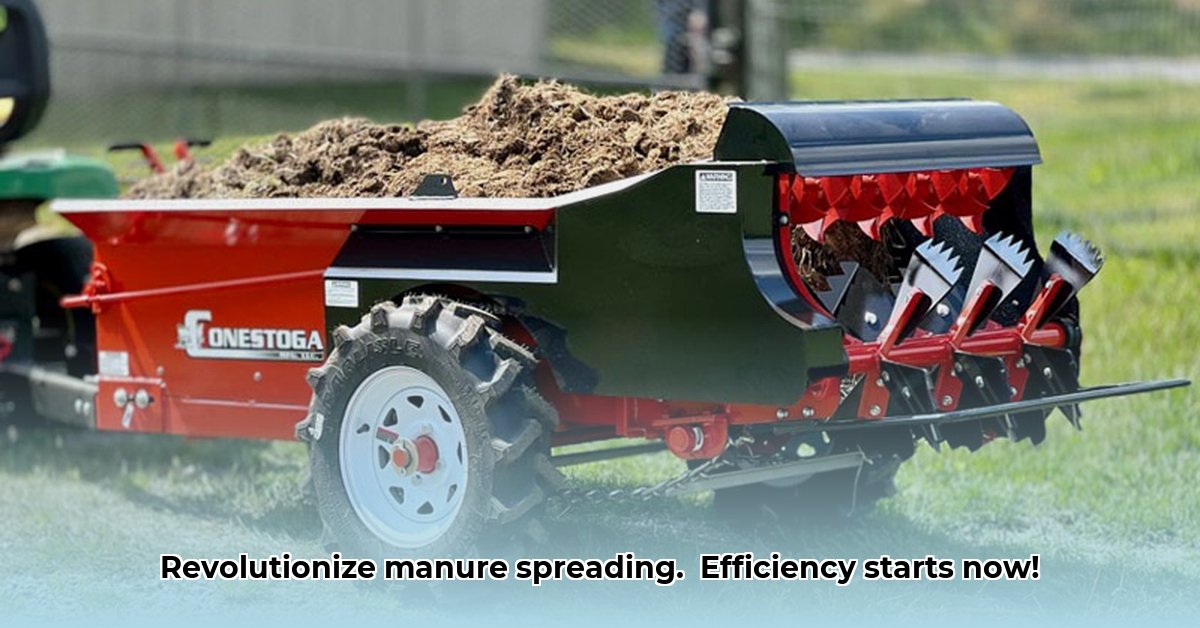
Understanding Your Manure Spreader Tractor
Choosing the right manure spreader tractor is crucial for efficient farm operations. The ideal machine depends heavily on your specific needs. Do you manage a large acreage demanding high-capacity spreading, or a smaller operation prioritizing maneuverability? The type of manure—thick, liquid, or mixed—also significantly impacts your selection. Careful consideration upfront prevents future problems and unnecessary expenses. Are you ready to optimize your spread? For more information on tractor supplies, check out this helpful resource: Tractor Supply Guide.
Types of Manure Spreaders: Finding the Right Fit
Several manure spreader types cater to different needs and manure consistencies. Understanding these differences is key to selecting the optimal equipment for your farm.
Trailing Spreaders: These are towed behind a tractor, making them ideal for smaller farms valuing simplicity and ease of maintenance. They represent a cost-effective and reliable entry point into manure spreading.
Self-Propelled Spreaders: Suited for larger operations, these powerful machines handle greater manure volumes independently, eliminating the need for a towing tractor. This boosts efficiency on extensive farms.
Liquid Manure Spreaders: Specifically designed for liquid manure, these spreaders utilize pumps and injectors for precise, even application, maximizing nutrient utilization and minimizing waste.
Combination Spreaders: Offering unmatched versatility, combination spreaders manage both solid and liquid manure, reducing the need for multiple pieces of equipment and streamlining your operations.
Consider your farm's size, manure type, and budget when choosing. Thorough assessment before purchasing is essential. What's the best fit for your operation?
Optimizing Manure Spreader Tractor Performance: A Tune-Up for Success
Regular maintenance is key to maximizing your manure spreader's efficiency and lifespan. Proactive care prevents costly repairs and downtime.
Belt and Chain Inspection: Regularly inspect belts and chains for wear and tear. Prompt replacement prevents larger, more expensive issues later. This preventative maintenance ensures consistent performance and saves money.
Lubrication: Adequate lubrication of moving parts ensures smooth operation and extends equipment life. Regular lubrication is a small effort with significant long-term returns.
Cleaning: Manure buildup causes clogs and uneven spreading. Regular cleaning is vital for consistent performance and effective fertilizer application. A clean spreader means efficient spreading.
Spread Pattern Check: Ensure even manure distribution across fields. Adjust settings as needed to optimize nutrient application and avoid resource waste. This precision translates to better crop yields.
These simple maintenance steps ensure peak performance and extend your tractor's lifespan, saving you money and maximizing ROI. How regularly do you perform these checks?
Safety First: Prioritizing Your Well-being
Safety is paramount when operating farm machinery. Simple precautions prevent accidents.
Protective Gear: Always wear appropriate safety gear, including sturdy footwear, gloves, eye protection, and hearing protection. Prioritize your safety.
Pre-Operation Inspection: Thoroughly inspect equipment before operation to identify any potential hazards. Prevention is key to avoiding accidents and injuries.
Manufacturer Instructions: Always follow the manufacturer's instructions carefully. This is fundamental to safe and efficient operation.
Situational Awareness: Pay close attention to your surroundings, maintaining safe distances from obstacles, people, and livestock. This attentive approach minimizes risks.
Alertness: Never operate machinery when fatigued or under the influence of substances. Clearheadedness is crucial for safe operation of heavy equipment. Remember, safety is non-negotiable.
Troubleshooting Common Issues: Quick Fixes and Solutions
Even with proper maintenance, issues may arise. Here’s a quick guide to resolve some common problems:
| Problem | Possible Cause(s) | Solution |
|---|---|---|
| Uneven manure distribution | Incorrect settings, clogged augers, worn components | Adjust settings, clean the spreader, replace worn parts |
| Clogged augers/impellers | Manure buildup, foreign objects, damaged components | Clean and inspect augers/impellers, repair or replace parts |
| Belt slippage | Worn belts, loose tension, damaged pulleys | Replace belts, adjust tension, replace pulleys |
| Hydraulic issues | Low fluid levels, leaks, pump failure | Check fluid levels, repair/replace leaking components, check pump |
Addressing problems promptly maintains operational efficiency and extends equipment lifespan. What’s your strategy for handling unexpected issues?
Master Manure Management with Tractors: Maximize Efficiency Now
Key Takeaways:
- Modern manure spreaders significantly improve nutrient use and reduce environmental impact.
- Spreader selection depends on farm size, manure type, terrain, and budget.
- Precision application using GPS technology optimizes crop yields and minimizes runoff.
- Consider initial investment costs, operator training, and potential government subsidies.
- Regular maintenance and safety adherence are vital for efficiency and risk reduction.
Remember, efficient manure management is key to a successful and sustainable farming operation. By understanding your equipment, performing regular maintenance, and prioritizing safety, you'll maximize the efficiency of your manure spreading operation and contribute to a productive and sustainable farm.